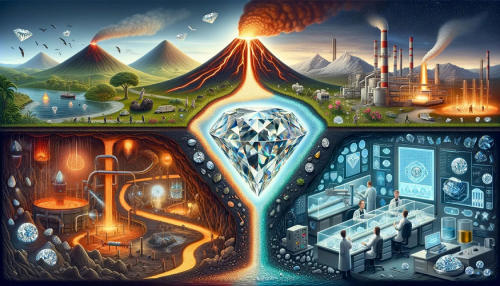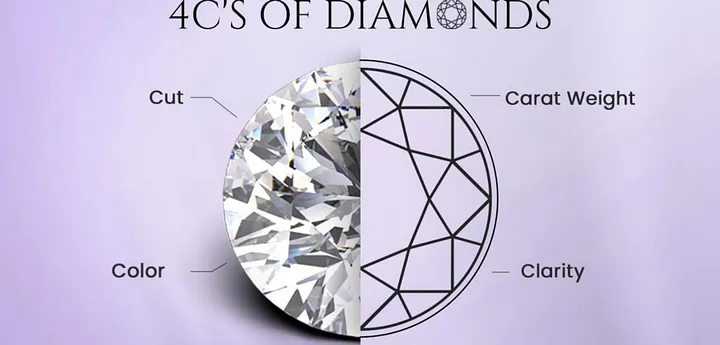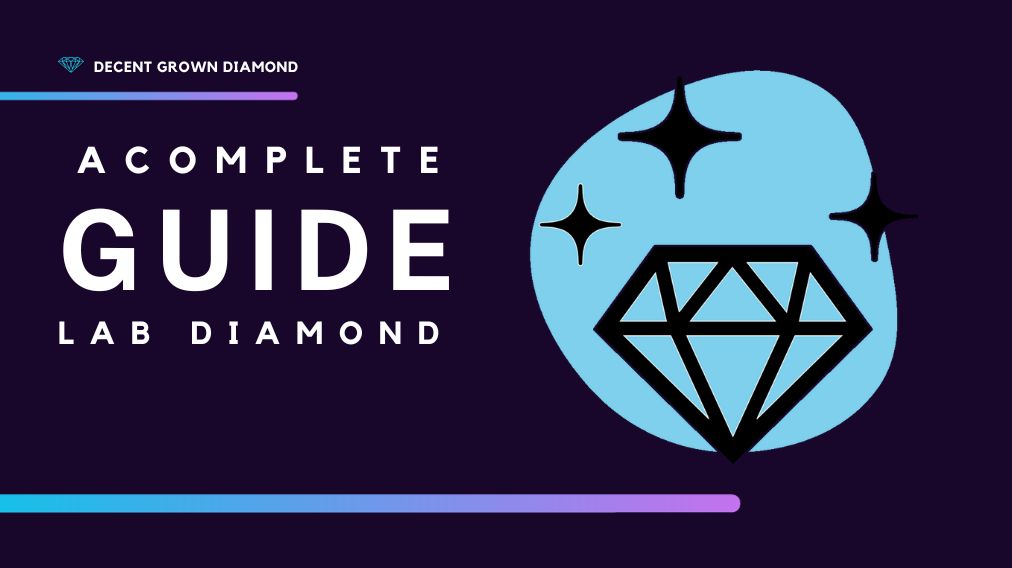Lab Grown Diamonds – A Complete Guide
Diamonds have long been associated with luxury, elegance, and timeless beauty. However, the traditional diamond industry has faced its fair share of ethical and environmental concerns. Enter lab-grown diamonds, a revolutionary alternative that offers all the beauty and brilliance of natural diamonds, but with a more sustainable and ethical approach.
In this comprehensive guide, we will delve into every aspect of lab-grown diamonds – from their creation process to their qualities, advantages, and even how to shop for one.
Whether you’re a diamond aficionado or simply curious about this innovative industry, this blog post will equip you with all the knowledge you need to make informed decisions and appreciate the wonders of lab-grown diamonds.
1. Introduction: Understanding Lab-Grown Diamonds
What are lab-grown diamonds?
Lab-grown diamonds, also known as synthetic or cultured diamonds, are diamonds that are created in a laboratory rather than being mined from the Earth.
These diamonds have the same chemical and physical properties as natural diamonds, but they are created through a process called Chemical Vapor Deposition (CVD) or High Pressure-High Temperature (HPHT).
Lab-grown diamonds are essentially made by replicating the conditions that occur deep within the Earth’s crust where natural diamonds are formed.
This process involves placing a small diamond seed in a sealed chamber and exposing it to carbon-rich gases or extreme pressure and temperature. Over time, the carbon atoms bond together and form a diamond crystal.
The result is a beautiful and ethically sourced diamond that is visually indistinguishable from a natural diamond.
How are they different from natural diamonds?
One of the key differences is the time it takes for lab-grown diamonds to form, which can be a matter of weeks or months, compared to the millions of years it takes for natural diamonds to be created.
This shorter timeframe makes lab-grown diamonds more sustainable and less environmentally impactful.
Additionally, lab-grown diamonds often have fewer inclusions and can come in larger sizes, making them an attractive option for those seeking high-quality, ethically sourced diamonds.
However, it’s important to note that the market for lab-grown diamonds is still evolving, and their value and market demand may differ from natural diamonds.

Benefits of choosing lab-grown diamonds
Lab-grown diamonds offer an eco-friendly and sustainable alternative to mined diamonds, as they do not require extensive mining processes and have a lower environmental impact.
Additionally, they often come at a more affordable price point, making them accessible to a wider range of consumers. Overall, lab-grown diamonds are a remarkable creation that combines scientific ingenuity with ethical and environmental considerations, offering a brilliant and conscious choice for those seeking the beauty and allure of diamonds.
2. The Science Behind Lab-Grown Diamonds
How lab-grown diamonds are created in a laboratory
Lab-grown diamonds, also known as synthetic diamonds, are created through a fascinating process that takes place in a controlled laboratory environment.
The process begins with a tiny diamond seed, which is placed in a chamber that is filled with a carbon-rich gas.
This chamber is then subjected to extreme heat and pressure, replicating the natural conditions that occur deep within the Earth’s crust where diamonds are formed.
Over time, the carbon atoms in the gas begin to deposit onto the diamond seed, layer by layer, gradually building up the crystal structure of the diamond.
This process can take several weeks or months, depending on the desired size and quality of the diamond.
Once the diamond has reached its desired size, it is carefully cut and polished by skilled artisans to bring out its natural brilliance and beauty.
The result is a lab-grown diamond that is chemically, physically, and visually identical to a natural diamond, but with the added benefit of being created in a sustainable and eco-friendly manner.
Different methods used to grow diamonds
The growth of lab-grown diamonds has revolutionized the jewelry industry, providing a sustainable and ethical alternative to mined diamonds. There are several methods used to grow these diamonds in a laboratory setting.
One popular method is known as chemical vapor deposition (CVD). In this technique, a tiny diamond seed is placed in a chamber filled with carbon-rich gases such as methane.
The gases are then heated to extreme temperatures, causing the carbon atoms to separate and form layers upon the diamond seed, gradually growing a larger diamond.
Another method, called high-pressure high-temperature (HPHT), mimics the natural conditions under which diamonds are formed deep within the Earth.
Carbon is placed within a press and subjected to intense heat and pressure, causing it to crystallize into a diamond. Additionally, there is the ultrahigh-pressure process, which involves using a small diamond seed that is placed in a chamber with a carbon source.
The chamber is then subjected to extreme pressures using a hydraulic press, resulting in the growth of a larger diamond.
These various methods allow for the precise control of diamond growth and enable the production of high-quality lab-grown diamonds that are visually identical to their mined counterparts.
3. Comparing Lab Grown Diamonds to Natural Diamonds.
Differences in cost and pricing
One of the most significant advantages of lab grown diamonds is their cost. Lab-grown diamonds are typically priced at least 30% lower than their natural counterparts.
This is due to the fact that the production process for lab-grown diamonds is less complex and time-consuming, resulting in reduced costs.
Additionally, there is a greater supply of lab-grown diamonds, as they can be produced on demand, whereas natural diamonds require extensive mining efforts.
This increased supply helps to drive down the price of lab grown diamonds. However, it is important to note that the pricing of diamonds, both natural and lab-grown, is also determined by factors such as carat weight, cut, color, and clarity. So, while the initial cost of lab grown diamonds may be lower, the pricing can still vary depending on the specific characteristics of the diamond.
Environmental and ethical considerations
When it comes to considering the environmental and ethical impacts of diamonds, there is a growing trend towards lab-grown diamonds as a more sustainable alternative to natural diamonds.
Lab-grown diamonds are created in a controlled environment using advanced technology, eliminating the need for environmentally destructive mining practices.
Traditional diamond mining can result in deforestation, habitat destruction, and water pollution. In contrast, lab-grown diamonds require significantly less energy and water to produce, making them a more eco-friendly choice.
Additionally, ethical concerns surrounding the diamond industry, such as child labor and worker exploitation, are minimized with lab-grown diamonds as they are produced in a controlled setting.
This provides consumers with the confidence that the diamonds they are purchasing are free from unethical practices.
Ultimately, choosing lab-grown diamonds allows individuals to enjoy the beauty and brilliance of diamonds while making a conscious choice to protect the environment and promote ethical practices.
Physical characteristics and appearance
When it comes to comparing lab-grown diamonds to natural diamonds in terms of physical appearance, the two are nearly indistinguishable.
Lab-grown diamonds are created using advanced technology that replicates the natural process of diamond formation, resulting in diamonds that have the same chemical composition and crystal structure as natural diamonds.
This means that both types of diamonds exhibit the same brilliance, sparkle, and clarity.
Even gemologists struggle to differentiate between these diamonds without the use of specialized equipment.
The only subtle differences can be found under high magnification, where some lab-grown diamonds may exhibit certain growth patterns that differ from natural diamonds.
However, these distinctions are only visible to trained professionals and not to the naked eye. Ultimately, whether you choose a lab-grown or natural diamond, you can be confident in the beauty and elegance of either option.
4. Factors to Consider When Buying Lab-Grown Diamonds
Understanding the 4Cs (carat, cut, color, clarity)
When it comes to buying lab-grown diamonds, it’s essential to consider the 4 C’s: cut, color, clarity, and carat weight. The cut of a lab-grown diamond determines how well it reflects light, and a well-cut diamond will have optimal sparkle and brilliance.
Color is another important factor, as lab-grown diamonds can come in a variety of shades. While most lab-grown diamonds are colorless, some may have a slight hint of color, which can affect their value.
Clarity refers to the presence of any internal or external flaws in the diamond, and a higher clarity grade indicates a cleaner and more flawless stone. Lastly, carat weight refers to the size of the diamond, with larger diamonds typically being more valuable.
By considering these 4 C’s, you can ensure that you are making an informed decision when purchasing a lab-grown diamond, and find the perfect stone that suits your preferences and budget.

Certification and grading of lab grown diamonds
When it comes to buying lab-grown diamonds, it’s essential to consider the certification and grading of the diamond before making a purchase. Certification provides assurance that the diamond has undergone rigorous testing and meets certain quality standards.
The Gemological Institute of America (GIA) is one of the most reputable and widely recognized gemological laboratories that provides certification for lab-grown diamonds.
Their grading report includes important information such as the diamond’s carat weight, color, clarity, and cut. This report serves as a guarantee of the diamond’s authenticity and quality.
Additionally, it is crucial to understand the different grading scales and terminology used for lab-grown diamonds.
This knowledge will help you make an informed decision and ensure that you are getting a diamond that matches your preferences and budget.
By considering the certification and grading of lab-grown diamonds, you can have peace of mind knowing that you are purchasing a high-quality and reliable gemstone.
Choosing a reputable retailer or manufacturer
When it comes to purchasing lab-grown diamonds, it is crucial to choose a reputable retailer or manufacturer to ensure that you are getting a high-quality and ethical product.
One of the first things to consider is the company’s certifications and accreditations. Look for retailers or manufacturers that are certified by recognized organizations such as the Gemological Institute of America (GIA) or the International Gemological Institute (IGI). These certifications provide assurance of the diamond’s authenticity and quality.
Additionally, it is important to research the company’s reputation and customer reviews.
Look for feedback from previous customers to get a sense of their satisfaction with the diamonds and the overall buying experience.
A reliable and reputable retailer or manufacturer should also provide clear and transparent information about the diamond’s origin, grading, and any additional treatments or enhancements.
Lastly, consider the company’s commitment to sustainability and ethical practices.
Look for retailers or manufacturers that prioritize responsible sourcing and have policies in place to ensure that their lab-grown diamonds are produced in an environmentally friendly and socially responsible manner.
By taking these factors into account, you can make an informed decision and choose a reputable retailer or manufacturer for your lab-grown diamond purchase.
We at DECENT, fulfill all of these requirements without burning a huge hole in your pocket.
5. Care and Maintenance of Lab Grown Diamonds
Lab-grown diamonds have become an increasingly popular choice for those seeking a more ethical and sustainable alternative to traditional mined diamonds.
While these diamonds are created in a controlled laboratory environment, they still require proper care and maintenance to keep them looking their best. Firstly, it is important to clean them regularly to maintain their brilliance.
This can be done by soaking the diamond in a solution of warm water and mild dish soap, gently scrubbing it with a soft toothbrush, and rinsing it thoroughly.
Avoid using harsh chemicals or abrasive cleaners, as they can damage the diamond’s surface.
Additionally, it is advisable to store lab-grown diamonds separately from other gemstones to prevent scratches. A soft fabric-lined jewelry box or a pouch is an ideal storage option.
Lastly, it is recommended to have lab-grown diamonds professionally inspected and cleaned by a jeweler at least once a year to ensure their longevity and sparkle.
With proper care, lab-grown diamonds can remain a stunning and sustainable choice for generations to come.
6. FAQ about Lab-Grown Diamonds
Are lab-grown diamonds real?
Yes, lab-grown diamonds are indeed real diamonds.
They share the same physical, chemical, and optical properties as natural diamonds because they are made of the same carbon crystal structure.
The primary difference between lab-grown and natural diamonds lies in their origin.
Can you distinguish lab grown diamonds from natural diamonds?
In most cases, it can be challenging to distinguish lab-grown diamonds from natural diamonds without specialized equipment and expertise. Lab-grown diamonds share nearly identical physical, chemical, and optical properties with natural diamonds.
Here are a few methods that experts might use to distinguish between the two:
Microscopic Examination:
- Certain features, such as growth patterns, inclusions, and other characteristics, can be examined under a microscope.
- While both natural and lab-grown diamonds can have similar features, certain growth patterns or inclusions may provide clues.
Laser Inscription:
- Some lab-grown diamonds are laser-inscribed with a microscopic identifier. This inscription is often visible under magnification and may indicate that the diamond is lab-grown.
Specialized Testing Equipment:
- Advanced testing equipment, such as spectrometers and detectors, can be used to analyze the diamond’s composition. Certain trace elements or characteristics may differ between natural and lab-grown diamonds.
Fluorescence Patterns:
- The fluorescence pattern of a diamond under ultraviolet light can sometimes provide information about its origin. However, this is not foolproof, as both natural and lab-grown diamonds can exhibit fluorescence.
It’s important to note that these methods require specialized knowledge and equipment and may not be easily done by the average consumer.
In most cases, consumers can rely on the information provided by reputable jewellers and certifications from gemological laboratories to ensure the authenticity of their diamonds.
If you’re uncertain about the origin of a diamond, consulting with a professional gemologist or relying on reputable sources with transparent practices is recommended. Additionally, many lab-grown diamonds are disclosed and come with certifications specifying their origin.
Can lab grown diamonds be resold?
Yes, lab-grown diamonds can be resold, just like natural diamonds. The resale value of any diamond, whether lab-grown or natural, is influenced by several factors:
Market Demand:
- The demand for lab-grown diamonds is increasing, and as awareness and acceptance grow, the resale market for lab-grown diamonds may become more established.
Quality and Characteristics:
- The quality of the lab-grown diamond, including factors like cut, color, clarity, and carat weight (often referred to as the “Four Cs”), will impact its resale value.
Certification:
- Having a reputable certification from a recognized gemological laboratory can enhance the resale value. Certificates provide detailed information about the diamond’s characteristics, helping buyers make informed decisions.
Transparency:
- Transparent disclosure about the diamond being lab-grown is important. Ethical practices and clear communication can contribute positively to the resale process.
Market Trends:
- Staying informed about market trends and consumer preferences in the diamond industry can help determine the optimal time to sell a lab-grown diamond.
It’s worth noting that, in general, diamonds, whether lab-grown or natural, may not retain their retail value as well as some other investments. The resale value can be influenced by various factors, and individual experiences may vary.
If you’re considering reselling a lab-grown diamond, it’s advisable to work with reputable jewelers, gemologists, or specialized platforms that deal with pre-owned diamonds. They can provide assessments, facilitate transactions, and guide you through the process. Keep any documentation, such as certificates and purchase receipts, as they can be valuable during the resale process.
For more questions related to lab grown diamonds, Visit our FAQ section.

